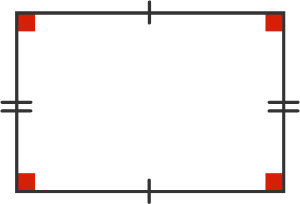Properties of Rectangles
A rectangle is a parallelogram with four right angles. Rectangles are much simpler to deal with than the general case of a parallelogram.
Contents
Basic Properties
The fundamental definition of a rectangle is as follows.
A rectangle is a quadrilateral whose interior angles are all equal.

Since the sum of the interior angles of a polygon is \( 360^\circ \), it follows that each of the interior angles is a right angle.
Property 1. Each of the interior angles of a rectangle is \( 90^\circ \).
Since the opposite interior angles are equal, it immediately follows that all rectangles are parallelograms, whose properties apply to rectangles:
Property 2. The diagonals of a rectangle bisect each other.
Property 3. The opposite sides of a rectangle are parallel.
Property 4. The opposite sides of a rectangle are equal.
Property 5. A rectangle whose side lengths are \( a \) and \( b \) has area \( a b \sin{90^\circ} = ab. \)
Property 6. A rectangle whose side lengths are \( a \) and \( b \) has perimeter \( 2a + 2 b \).
Maximum area. Suppose the perimeter of a rectangle is fixed at \( P \), but the sides, of length \( x \) and \( P/2 - x \) are free to change. For what value of \( x \) is the area of the rectangle largest?
The area \( A \) of the rectangle is \( A = x (P/2 - x) \). To find the value of \( x \) for which \( A \) is maximum, we complete the square by adding some constant \( c \) to both sides:
\[ A + c = P x / 2 - x^2 + c. \]
The choice of \( c = P^2 / 16 \) allows us to factor the right side as a perfect square:
\[ A + P^2 / 16 = -(x - P/4)^2, \]
which leads us to
\[ A = P^2 / 16 - (x - P/4)^2. \]
Clearly, the maximum value of \( - (x - P/4)^2 \) is zero, so the maximum value of \( P^2 / 16 - (x - P/4)^2 \) is \( P^2 / 16 \). This implies that \( x = P / 4 \). In other words, given a fixed total perimeter, the area of a rectangle is greatest when both sides are the same length (each equal to a fourth of the total perimeter).
Because each interior angle is a right angle, the Pythagorean theorem allows for the calculation of the length of the diagonals. By symmetry, both diagonals must be of equal length.
Property 7. The length of each diagonal of a rectangle whose side lengths are \( a \) and \( b \) is \( \sqrt{a^2 + b^2}. \)
Suppose each diagonal of a rectangle is of length \( D \) while the perimeter is \( P \). Find the area \( A \) of the rectangle.
Let \( a \) and \( b \) be the side lengths of the rectangle. Then
\[ \begin{align} a^2 + b^2 &= D^2 \\ a + b &= P/2. \end{align} \]
Squaring the second equation yields
\[ a^2 + 2ab + b^2 = P^2 / 4. \]
Subtracting the first equation then gives
\[ 2ab = P^2 / 4 - D^2, \]
or
\[ A = ab = \dfrac{P^2 - 4D^2}{8}. \]
Suppose each diagonal of a rectangle is of length \( D \) while the area is \( A \). Find the perimeter \( P \) of the rectangle.
From the result in our previous example, we have
\[ P^2 = 8A + 4D^2, \]
so
\[ P = \sqrt{8A + 4D^2}. \]
Property 8. Both of the diagonals of a rectangle have the same length.
Rectangle \(ABCD\) has lengths \(AB=3\) and \(BC=4\). What is the length of \(BD\)?
Using property property 7, \[AC=\sqrt{3^2+4^2}=\sqrt{25}=5\] Knowing that \(AC=BD\), \(BD=\boxed{5}\)
Additional Properties

Because the diagonals are of equal length and bisect each other, it must be the case that each vertex of a rectangle must be equidistant from the point of bisection \( O \). It follows that there exists a circumcircle through \( O \) that passes through the four vertices of the rectangle.
Property 9. Let \( O \) be the intersection of the diagonals of a rectangle. There exists a circumcircle centered at \( O \) whose radius is equal to half of the length of a diagonal.
Property 10. Each diagonal of a rectangle is a diameter of its circumcircle.
Area bounded by an arc and rectangle. A rectangle with side lengths \( a \) and \( b \) is circumscribed as shown. Determine the area of the dark blue section.

We can consider the dark blue area as equal to the area inside the arc that subtends the shaded area minus the fourth of the rectangle (the triangular wedge) that is under the arc but not part of the dark blue area.
The arc that bounds the dark blue area is subtended by an angle \( 2 \theta \) (\( \theta \) defined in radians), where \( \tan{\theta} = a/b \). Therefore, the area under the arc is given by
\[ \pi R^2 \frac{2\theta}{2\pi} = \theta (a^2 + b^2) / 4, \]
where \( R = \sqrt{a^2 + b^2}/2 \) is the radius of the circle. Finally, subtracting a fourth of the rectangle's area gives a total dark blue area of
\[ \frac{1}{4} \left[(a^2 + b^2) \arctan(a/b) - ab \right]. \]

In the diagram above, each circle is in contact two other circles and at least one side of the rectangle. The radii are perpendicular to the sides of the rectangle as shown. Find the area of the shaded portion in \(\text{cm}^2\) to the nearest whole number.
All dimensions are in cm.
Use \( \pi \approx 3.14159 \).

